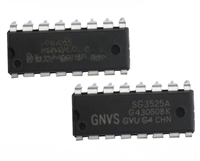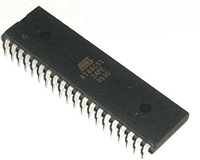LM4876
SNAS054E –FEBRUARY 2000–REVISED MAY 2013
www.ti.com
APPLICATION INFORMATION
BRIDGE CONFIGURATION EXPLANATION
As shown in Figure 1, the LM4876 consists of two operational amplifiers. External resistors Rf and Ri set the
closed-loop gain of Amp1, whereas two internal 40kΩ resistors set Amp2's gain at -1. The LM4876 drives a load,
such as a speaker, connected between the two amplifier outputs, Vo1 and Vo2 .
Figure 1 shows that the Amp1 output serves as the Amp2 input, which results in both amplifiers producing
signals identical in magnitude, but 180° out of phase. Taking advantage of this phase difference, a load is placed
between Vo1 and Vo2 and driven differentially (commonly referred to as "bridge mode"). This results in a
differential gain of
AVD = 2 * (Rf/Ri)
(1)
Bridge mode is different from single-ended amplifiers that drive loads connected between a single amplifier's
output and ground. For a given supply voltage, bridge mode has a distinct advantage over the single-ended
configuration: its differential output doubles the voltage swing across the load. This results in four times the
output power when compared to a single-ended amplifier under the same conditions. This increase in attainable
output power assumes that the amplifier is not current limited or that the output signal is not clipped. To ensure
minimum output signal clipping when choosing an amplifier's closed-loop gain, refer to the AUDIO POWER
AMPLIFIER DESIGN section.
Another advantage of the differential bridge output is no net DC voltage across the load. This results from biasing
Vo1 and Vo2 at half-supply. This eliminates the coupling capacitor that single supply, single-ended amplifiers
require. Eliminating an output coupling capacitor in a single-ended configuration forces a single-supply amplifier's
half-supply bias voltage across the load. The current flow created by the half-supply bias voltage increases
internal IC power dissipation and may permanently damage loads such as speakers.
POWER DISSIPATION
Power dissipation is a major concern when designing a successful bridged or single-ended amplifier. Equation 2
states the maximum power dissipation point for a single-ended amplifier operating at a given supply voltage and
driving a specified output load.
PDMAX = (VDD)2 /(2π2 RL) Single-Ended
(2)
However, a direct consequence of the increased power delivered to the load by a bridge amplifier is higher
internal power dissipation for the same conditions.
The LM4876 has two operational amplifiers in one package and the maximum internal power dissipation is four
times that of a single-ended amplifier. Equation 3 states the maximum power dissipation for a bridge amplifier.
However, even with this substantial increase in power dissipation, the LM4876 does not require heatsinking.
From Equation 3, assuming a 5V power supply and an 8Ω load, the maximum power dissipation point is 633mW.
PDMAX = 4*(VDD)2 /(2π2 RL ) Bridge Mode
(3)
The maximum power dissipation point given by Equation 3 must not exceed the power dissipation given by
Equation 4:
PDMAX = (TJMAX -TA) /θJA
(4)
The LM4876's TJMAX = 150°C. In the D package, the LM4876's θJA is 140°C/W. At any given ambient
temperature TA, use Equation 4 to find the maximum internal power dissipation supported by the IC packaging.
Rearranging Equation 4 results in Equation 5. This equation gives the maximum ambient temperature that still
allows maximum power dissipation without violating the LM4876's maximum junction temperature.
TA = TJMAX - PDMAX θJA
(5)
For a typical application with a 5V power supply and an 8W load, the maximum ambient temperature that allows
maximum power dissipation without exceeding the maximum junction temperature is approximately 61°C.
TJMAX = PDMAX θJA + TA
(6)
8
Submit Documentation Feedback
Copyright © 2000–2013, Texas Instruments Incorporated
Product Folder Links: LM4876






 SG3525资料手册详解:SG3525参数分析、引脚说明、应用介绍
SG3525资料手册详解:SG3525参数分析、引脚说明、应用介绍

 AT89C51单片机资料手册详细解析及应用示例
AT89C51单片机资料手册详细解析及应用示例

 CP2102资料手册解读:CP2102引脚说明、关键参数分析
CP2102资料手册解读:CP2102引脚说明、关键参数分析

 资料手册解读:UC3842参数和管脚说明
资料手册解读:UC3842参数和管脚说明
